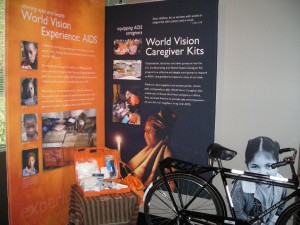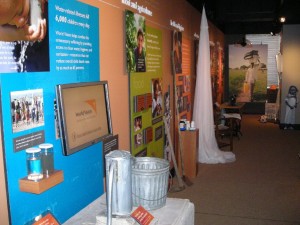I went to the World Vision US Headquarters on Wednesday December 23.
World Vision is the name for a non-profit organization founded in America in 1950 to do humanitarian aid and social development, especially in developing countries, and especially for the sake of children. Their m.o. is to get people in first-world countries to give a certain amount of money per month to a child in a third world country (aka child sponsorship) in exchange for the privilege to communicate with and get updates about that child. World Vision also has corporate sponsors, like for example, there is a famous popular story known that they get sports gear prepared before major games which becomes unusable due to it promoting the losing team as having won. World Vision is now a network of organizations that share a name but have limited dependency on other units, so the organization registered as World Vision in any country does not necessarily answer to the World Vision in America, for example.
The scale of World Vision is beyond my experience of comprehending. The American organization spent about 1,100,000,000 (1.1 billion) US dollars in 2008. $467,000,000 was from private contributions meaning from people, not government or corporations. Heather Malroy was my tour guide, and she said that their office gets a minimum of 5,000 pieces of correspondence a day and about 80,000 a day around Christmas. Most of these are from private contributors either writing to or writing about the child whom they are sponsoring. They have three office buildings in Federal Way (a city near Seattle). I am posting pictures of those here. In these three buildings are 1,000 full-time salaried employees, almost all of whom are office workers. Malroy told me that these buildings are expected to be of sufficient size to last through 2011, and presumably after then more space will be needed. What happens in these buildings is largely unrelated to what happens in World Vision in other countries. I have not read the particulars or done data research, but Malroy led me to believe that there are similar such arrangements branded by World Vision in other first-world countries.
As I understand, World Vision’s model is to find social workers native in a target area and have them organize World Vision’s projects according to some common protocol. Some typical projects are programs to get children (minors) through school, programs to improve schools themselves, well-digging, clinic establishment, and child meal programs. So I understand, the local social workers are hired at a local salary, and they are charged with protecting the integrity of the funding and monitoring program efficacy and progress, as well as facilitating communication between individual sponsors and the sponsored children. Part of this must be translation, as sponsors often will not speak the same language as sponsored children. When a child writes to a sponsor, the letter must be translated, then stapled to the original, then both original and translation are mailed to the headquarters in the sponsor’s country, then the headquarters mails the letter to the sponsor.
World Vision is a Christian organization and part of their mission is glorifying a Christian concept of God, but I am not sure what that means. Malroy was interested in proselytizing, but I have no good understanding of what World Vision policy is. The way she explained it to me is that if asked, World Vision employees are trained to provide Christian teaching, which I assume means evangelicalism. but do not know if WV subscribes to some established denomination.
World Vision’s website gives a lot of information but a criticism I have of that website is that it seems like a sales pitch. That is not a bad thing, but I visited the website as a social researcher, and I think an organization of that size could well have an extensive social research network and be sitting on a data mine. I was not able to determine through the website or Malroy the extent to which WV collects or maintains social data, but my opinion is that if interesting survey data does not exist in abundance then the organization could not be sufficiently tracking its money. On the other hand, I could understand how such an organization would not want to publish raw data, because there really are not many people like me who would criticize them for not having it, and because it is more likely that someone would review it negatively than positively even if it did show respectable results. I really think that the organization is doing some good work, but I am just guessing that perhaps management has not caught up to the modern computer generation which I feel I am representing in wanting data, and that really does not surprise me when I imagine the demographic of sponsors of children.
Seriously, I have not done enough research about this organization to properly critique them, so no one should take what I am saying as negative, but rather just as talking points. Look at their Youtube channel. At least they have one, which is more than some organizations do. Right now they have 102 videos, with the oldest one being from two years ago. 56 of those videos were uploaded in the past six months. I watched some of these videos, and was unable to find any that was data-heavy and made without what I would call an intent to self-promote or advertise. Of course they do not owe the general public data or research product, but provision of data is what I personally would want to have a large increase in comfort with WV’s organizational model. It is a good sign that they are recognizing the need to continually output content, though.
The World Vision US Headquarters has a visitor’s center that anyone can drop in and tour. It was nice to have a tour guide, and I would recommend that anyone interested go there and learn about what they do and how they do it, as they present themselves.





